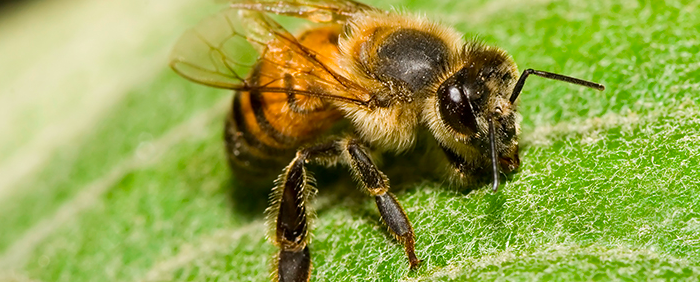
Researchers trained bees to recognize images with the smallest number of elements and showed that they understood the concept of zero. This is surprising for an insect that has less than a million neurons, when the human brain contains 86 billion.
The bee is an interesting model for studying the intelligence of insects: they learn from each other and understand abstract concepts like similarity and difference. But their intelligence does not stop there, as shown in an article in Science , which describes the work of researchers from the Royal Institute of Technology in Melbourne (Australia) and the University of Toulouse.
The bees were trained to choose, between two images, the one that had the least elements. During the test, they were rewarded with a sweet solution. Thus, between images with three or four elements, the bees had to choose the image with three elements. If the researchers presented an image without an element and one with one or more, the bees understood that zero was the smallest number.
A not so obvious abstract concept
Bees therefore understand the mathematical concept of zero, which is not so obvious, as Adrian Dyer, one of the authors , explains in a statement : “Zero is a difficult concept to comprehend and a mathematical skill that does not come easily . “ It would take several years for children to learn! He adds, “We have long believed that only humans had the intelligence to get the concept, but recent research has shown that monkeys and birds have brains for that. What we did not know – until now – is if insects can also understand zero. “
If small brains can include abstract concepts, this opens up new possibilities for developing artificial intelligences . This work could also help to understand how a brain represents the concept of zero.
Bees would be able to elaborate abstract concepts!
Amazing discovery of a CNRS team: bees know how to apprehend abstract concepts and even two at a time. They can learn to fetch food where there are two images of any kind, and even unknown to them, provided, for example, that they are placed one above the other, and that they are different.
The insect brain is able to make and manipulate abstract concepts. He can even use two different concepts simultaneously to make a decision in the face of a new situation. This totally unexpected result was obtained by the team of Professor Martin Giurfa , at CRCA (Research Center on Animal Cognition , CNRS / University Toulouse III-Paul Sabatier). This ability, believed to be unique to humans and some primates , shows that sophisticated cognitive analyzes are possible in the absence of language and despite a miniaturized neural architecture. These works, published in the journal Pnas, challenge many theories in areas such as animal cognition, human psychology, neuroscience and artificial intelligence .
Human cognition, including our mathematical and linguistic abilities, is based on our ability to manipulate concepts. In everyday life, concepts that connect distinct objects by “same”, “different”, “more than”, “above” relationship rules take on a prominent place. For example, the motorist is guided by a complex network of concepts: color codes , arrows, panels … The use of such concepts, which we often thought proper to humans and some primates , could be much more prevalent in the animal kingdom.
One above the other, it is not next to each other: the bee knows it
The experiences of Martin Giurfa’s team focus on bees , who were already amazed by their ability to recognize human faces and the existence of a kind of personality. .
Researchers have shown that these insects are able to generate and then manipulate concepts to access a food source. For this, they took a group of bees they trained to enter a chamber, to harvest the sweet solution. In this chamber, the bees encountered two stimuli each placed on a partition. Each stimulus was composed of two distinct images, one above the other or one next to the other. In the middle of these pairs of objects was placed an orifice delivering, either a reward, sweet water, or a punishment, a drop of quinine . So beeswere rewarded on one concept (eg “above”) and punished on the other (“next to”). The images constantly varied while maintaining the “above” and “beside” relationships as well as their respective associations to reward and punishment. After about thirty trials, the bees recognized without fault the relationship that would guide them to the sugar water.

The bee can handle a double abstract concept
One of the tests was to place these same bees in front of new images. The only common point with the figures of the training was their arrangement: “one above the other” and “one next to the other”. The bees, although never having seen these new images, have correctly chosen the target according to this abstract order relation.
But that’s not all: during the training, the images in which the reward was located were always different from each other. To find out if the bees had also learned this relationship of difference, the researchers confronted them with new stimuli where the constituent images respected the rewarded relationship (eg “one above the other”) but which were either different, identical. The bees ignored the stimuli made of identical images, showing that in addition to the concepts “above / below” and “beside”, they simultaneously manipulated the concept of “difference” to make their decision.
This study challenges the idea that mammalian brains (including ours), larger in size, are necessary for the development of conceptual knowledge. It also demonstrates that the formation of concepts is possible in the absence of language . From a philosophical point of view, it brings new elements to the discussion of what is specific to man . Martin Giurfa’s team is currently working on identifying the neural networks responsible for this conceptualization.